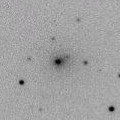
|
Bright new comet. Now it is very bright as 8.3 mag (Jan. 29, Katsumi Yoshimoto). It will approach to Earth down to 0.3 a.u. in February. Then it will brighten up to 7 mag and will be observable in excellent condition.
Date(TT) R.A. (2000) Decl. Delta r Elong. m1 Best Time(A, h)
Feb. 2 12 57.00 -12 11.3 0.516 1.289 114 8.2 4:12 ( 0, 42)
Feb. 9 11 27.05 3 28.5 0.338 1.287 148 7.2 2:19 ( 0, 57)
|
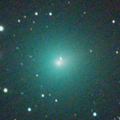
|
It approached to Earth down to 0.08 a.u. in mid December, and it brightened up to 3.4 mag (Dec. 14, Seiichi Yoshida). it looked so large as 3 times of Moon. Now it is fading. But it is bright as 7.7 mag still now (Jan. 29, Carlos Labordena). In the Northern Hemisphere, it stays observable in excellent condition. In the Southern Hemisphere, it is not observable until February.
Date(TT) R.A. (2000) Decl. Delta r Elong. m1 Best Time(A, h)
Feb. 2 9 25.90 54 37.3 0.321 1.254 142 7.4 0:40 (180, 70)
Feb. 9 9 30.36 52 28.4 0.374 1.304 142 8.2 0:17 (180, 72)
|

|
It brightened up to 7.7 mag in June (June 19, Juan Jose Gonzalez). Now it is fading. But it is still bright as 10.9 mag (Jan. 14, Chris Wyatt). In the Southern Hemisphere, it stays observable in good condition for a long time until the comet will fade out. In the Northern Hemisphere, it is not observable for a long time until autumn when the comet fades out down to 16 mag.
Date(TT) R.A. (2000) Decl. Delta r Elong. m1 Best Time(A, h)
Feb. 2 2 43.33 -74 51.7 3.108 2.964 72 11.4 18:55 ( 4,-20)
Feb. 9 3 2.15 -71 33.0 3.137 3.015 73 11.5 19:01 ( 6,-17)
|
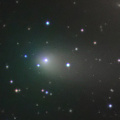
|
It brightened up to 9.5 mag from autumn to winter (Dec. 14, Marco Goiato). Now it is fading. But it is bright as 11.3 mag still now (Jan. 25, Carlos Labordena). In the Northern Hemisphere, it stays observable in good condition for a long time until it fades out. It locates low in the Southern Hemispehre.
Date(TT) R.A. (2000) Decl. Delta r Elong. m1 Best Time(A, h)
Feb. 2 8 28.11 47 18.1 0.980 1.894 149 11.4 23:39 (180, 78)
Feb. 9 8 26.69 47 28.4 1.048 1.940 145 11.8 23:10 (180, 78)
|
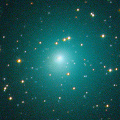
|
It brightened up to 9.0 mag from autumn to winter (Nov. 16, Maik Meyer). Now it is fading. But it is bright as 10.8 mag still now (Jan. 25, Carlos Labordena). It is observable in excellent condition in the Northern Hemisphere. It stays low in the Southern Hemisphere.
Date(TT) R.A. (2000) Decl. Delta r Elong. m1 Best Time(A, h)
Feb. 2 4 12.17 26 44.6 1.105 1.747 113 11.6 19:24 ( 0, 82)
Feb. 9 4 27.69 26 16.3 1.204 1.795 109 12.1 19:12 ( 0, 81)
|
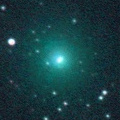
|
Now it is 10.4 mag (Jan. 3, Ken Harikae). It will be fading gradually after this. In the Northern Hemisphere, it stays observable for a long time until it fades out. But it stays extremely low. It will never be observable again in the Southern Hemisphere.
Date(TT) R.A. (2000) Decl. Delta r Elong. m1 Best Time(A, h)
Feb. 2 20 39.23 29 50.8 2.415 1.888 47 11.8 5:32 (242, 13)
Feb. 9 21 3.32 32 5.2 2.454 1.928 47 12.1 5:27 (240, 14)
|

|
Now it is 13.7 mag (Jan. 2, Toshihiko Ikemura, Hirohisa Sato). It stays at 12-13 mag for a long time until autumn.
Date(TT) R.A. (2000) Decl. Delta r Elong. m1 Best Time(A, h)
Feb. 2 23 53.98 0 26.3 2.628 2.072 46 12.6 18:55 ( 70, 27)
Feb. 9 0 8.33 1 43.2 2.669 2.060 42 12.5 19:01 ( 75, 24)
|

|
Now it is 12.8 mag (Jan. 23, Thomas Lehmann). It stays 12 mag for a long time until spring.
Date(TT) R.A. (2000) Decl. Delta r Elong. m1 Best Time(A, h)
Feb. 2 6 14.16 -22 12.4 2.717 3.363 123 13.0 21:24 ( 0, 33)
Feb. 9 6 3.52 -22 15.1 2.835 3.406 117 13.2 20:46 ( 0, 33)
|
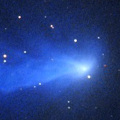
|
Now it is 13.6 mag (Jan. 16, Thomas Lehmann). It will be fading slowly after this. It is observable in good condition in the Northern Hemisphere. In the Southern Hemisphere, it will appear in the morning sky soon. But it stays extremely low for a while.
Date(TT) R.A. (2000) Decl. Delta r Elong. m1 Best Time(A, h)
Feb. 2 15 55.70 42 23.6 3.627 3.785 91 13.2 5:32 (242, 70)
Feb. 9 15 59.84 43 1.7 3.627 3.834 94 13.3 5:27 (237, 73)
|
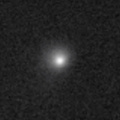
|
Now it is 14.6 mag (Jan. 22, Thomas Lehmann). It will brighten up to 10-11 mag in autumn. It will be unobservable temporarily in March.
Date(TT) R.A. (2000) Decl. Delta r Elong. m1 Best Time(A, h)
Feb. 2 1 4.84 -25 31.4 4.562 4.111 57 13.4 18:55 ( 38, 19)
Feb. 9 1 6.97 -23 40.3 4.603 4.071 52 13.4 19:01 ( 45, 16)
|
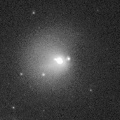
|
Now it is bright as 12.9 mag (Jan. 2, Toshihiko Ikemura, Hirohisa Sato).
Date(TT) R.A. (2000) Decl. Delta r Elong. m1 Best Time(A, h)
Feb. 2 23 18.27 1 55.1 6.500 5.767 38 13.8 18:55 ( 78, 20)
Feb. 9 23 23.09 2 25.5 6.566 5.767 33 13.8 19:01 ( 83, 15)
|
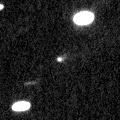
|
Now it is 12.6 mag (Jan. 21, Sandor Szabo). It is observable in excellent condition in the Northern Hemisphere. It locates low in the Southern Hemisphere.
Date(TT) R.A. (2000) Decl. Delta r Elong. m1 Best Time(A, h)
Feb. 2 11 40.52 30 23.7 1.268 2.127 141 13.9 2:54 ( 0, 85)
Feb. 9 11 38.96 31 0.4 1.236 2.127 146 13.9 2:25 ( 0, 86)
|
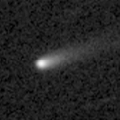
|
Now it is 13.5 mag (Jan. 28, Thomas Lehmann). It is observable at 14 mag in excellent condition until March.
Date(TT) R.A. (2000) Decl. Delta r Elong. m1 Best Time(A, h)
Feb. 2 11 46.71 -5 37.8 0.871 1.703 133 13.9 3:01 ( 0, 49)
Feb. 9 11 47.33 -6 9.1 0.851 1.725 139 14.0 2:34 ( 0, 49)
|
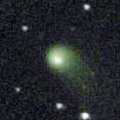
|
Now it is 13.9 mag (Jan. 19, Martin Masek). It stays 13-14 mag until summer.
Date(TT) R.A. (2000) Decl. Delta r Elong. m1 Best Time(A, h)
Feb. 2 17 26.84 -15 52.6 3.784 3.255 50 14.0 5:32 (310, 22)
Feb. 9 17 29.39 -17 6.9 3.685 3.258 57 14.0 5:27 (315, 24)
|
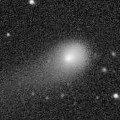
|
Now it is 14.6 mag (Jan. 10, Toshihiko Ikemura, Hirohisa Sato). It will be fading slowly after this. It is observable in excellent condition until spring in the Northern Hemispehre. In the Southern Hemisphere, it will be hardly observable after this.
Date(TT) R.A. (2000) Decl. Delta r Elong. m1 Best Time(A, h)
Feb. 2 10 46.16 43 30.3 3.959 4.802 145 14.5 2:01 (180, 82)
Feb. 9 10 32.49 44 0.2 3.975 4.839 147 14.5 1:20 (180, 81)
|
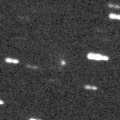
|
Now it is bright as 14.8 mag (Dec. 12, Kunihiro Shima). It stays 14 mag for a long time in 2019. In the Southern Hemisphere, it is observable in excellent condition. In the Northern Hemisphere, it is not observasble until summer in 2020.
Date(TT) R.A. (2000) Decl. Delta r Elong. m1 Best Time(A, h)
Feb. 2 10 52.96 -52 59.0 2.930 3.337 105 14.6 2:07 ( 0, 2)
Feb. 9 10 38.12 -55 12.3 2.866 3.312 108 14.5 1:25 ( 0, 0)
|

|
Now it is 14.3 mag (Nov. 30, Seiichi Yoshida). It stays at 14 mag until winter. It is observable in excellent condition in the Northern Hemisphere. In the Southern Hemisphere, it is not observable until summer.
Date(TT) R.A. (2000) Decl. Delta r Elong. m1 Best Time(A, h)
Feb. 2 12 8.80 81 21.9 1.596 2.177 112 14.6 3:24 (180, 44)
Feb. 9 11 23.42 80 57.0 1.629 2.207 112 14.7 2:12 (180, 44)
|

|
Now it is 14.5 mag (Aug. 16, P. Camilleri, H. Williams). It stays 15 mag from 2018 to 2019, and it will be observable for a long time in the Southern Hemisphere. In the Northern Hemisphere, it will never be observable again.
Date(TT) R.A. (2000) Decl. Delta r Elong. m1 Best Time(A, h)
Feb. 2 21 21.45 -60 22.4 4.577 3.921 43 14.9 18:55 ( 36,-32)
Feb. 9 21 38.56 -59 8.7 4.567 3.922 44 14.9 19:01 ( 38,-34)
|
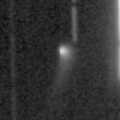
|
Now it is 14.6 mag (Jan. 21, Sandor Szabo). It stays 15 mag until March. It is observable in excellent condition in the Northern Hemisphere. It is not observable at all in the Southern Hemisphere.
Date(TT) R.A. (2000) Decl. Delta r Elong. m1 Best Time(A, h)
Feb. 2 5 24.18 74 28.0 2.733 3.282 115 15.3 20:33 (180, 51)
Feb. 9 4 42.52 71 55.3 2.818 3.287 109 15.4 19:25 (180, 53)
|
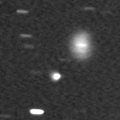
|
Now it is 15.5 mag (Jan. 25, Artyom Novichonok). It is expected to brighten up to 7-8 mag in 2020. It will be unobservable temporarily in April.
Date(TT) R.A. (2000) Decl. Delta r Elong. m1 Best Time(A, h)
Feb. 2 2 58.79 -1 15.7 5.302 5.381 89 15.4 18:55 ( 19, 52)
Feb. 9 2 58.78 -0 29.8 5.353 5.319 82 15.4 19:01 ( 32, 50)
|
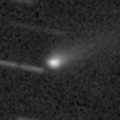
|
Although it was faint as 16-17 mag in November, it brightened up to 14.7 mag in December (Dec. 12, Toshihiko Ikemura, Hirohisa Sato). Now it is 15.5 mag (Jan. 21, Sandor Szabo). In the Northern Hemisphere, it stays observable in excellent condition after this. It stays extremely low in the Southern Hemisphere.
Date(TT) R.A. (2000) Decl. Delta r Elong. m1 Best Time(A, h)
Feb. 2 11 20.15 40 2.0 2.033 2.874 142 15.9 2:34 (180, 85)
Feb. 9 11 15.28 41 7.1 2.041 2.905 145 16.1 2:02 (180, 84)
|
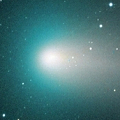
|
It brightened up to 6.8 mag in September (Sept. 17, Seiichi Yoshida). Now it is fading rapidly. It has already faded down to 13.8 mag (Jan. 6, Toshihiko Ikemura, Hirohisa Sato). It is observable in excellent condition in the Southern Hemisphere. It locates low after this in the Northern Hemisphere.
Date(TT) R.A. (2000) Decl. Delta r Elong. m1 Best Time(A, h)
Feb. 2 6 4.77 -27 4.8 1.420 2.081 118 16.4 21:15 ( 0, 28)
Feb. 9 6 5.40 -24 34.9 1.512 2.144 116 16.8 20:49 ( 0, 31)
|

|
First return of a new periodic comet discovered in 2014. It has not been recovered yet. Now it is not detected, fainter than 20.0 mag (Dec. 10, Toshihiko Ikemura, Hirohisa Sato). The condition of this apparition is excelllent. It will brighten rapidly, and will be observable at 15.5 mag in excellent condition in March.
Date(TT) R.A. (2000) Decl. Delta r Elong. m1 Best Time(A, h)
Feb. 2 10 28.99 7 11.0 0.938 1.882 156 16.6 1:43 ( 0, 62)
Feb. 9 10 26.69 7 36.6 0.888 1.857 163 16.4 1:13 ( 0, 62)
|

|
It is expected to brighten up to 10 mag in autumn. Now it is 17.2 mag (Dec. 31, Toshihiko Ikemura, Hirohisa Sato). In the Northern Hemisphere, it stays observable for a long time while the comet is brightening. In the Southern Hemisphere, it it not observable until mid September.
Date(TT) R.A. (2000) Decl. Delta r Elong. m1 Best Time(A, h)
Feb. 2 14 22.57 69 20.2 2.681 3.146 109 16.6 5:32 (181, 56)
Feb. 9 14 33.72 73 12.9 2.622 3.076 108 16.5 5:18 (180, 52)
|
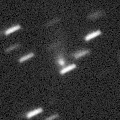
|
It brightened up to 8.7 mag in July (July 18, Marco Goiato). Then it faded down to 12.3 mag in August (Aug. 29, Chris Wyatt). It stays observable in good condition after this while the comet will be fading.
Date(TT) R.A. (2000) Decl. Delta r Elong. m1 Best Time(A, h)
Feb. 2 16 24.04 -16 59.8 3.391 3.116 65 16.6 5:32 (325, 30)
Feb. 9 16 26.39 -16 3.7 3.357 3.199 72 16.7 5:27 (329, 33)
|

|
Now it is 16.4 mag (Jan. 6, Toshihiko Ikemura, Hirohisa Sato). It stays 16-17 mag for a long time until 2020. It is observable in good condition in the Northern Hemisphere. It is not observable at all in the Southern Hemisphere.
Date(TT) R.A. (2000) Decl. Delta r Elong. m1 Best Time(A, h)
Feb. 2 11 52.24 73 36.4 7.931 8.447 118 16.6 3:06 (180, 52)
Feb. 9 11 47.56 73 55.4 7.940 8.446 117 16.6 2:34 (180, 51)
|
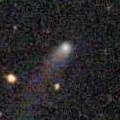
|
It brightened up to 14.7 mag in early 2018 (Jan. 25, Catalina Sky Survey). Now it is fading slowly. Now it is 16.4 mag (Jan. 3, Toshihiko Ikemura, Hirohisa Sato). In the Northern Hemisphere, it stays observable in good condition for a long time until the comet fades out. It is never observable again in the Southern Hemisphere.
Date(TT) R.A. (2000) Decl. Delta r Elong. m1 Best Time(A, h)
Feb. 2 4 51.97 72 7.1 5.742 6.217 114 16.9 20:03 (180, 53)
Feb. 9 4 38.24 71 30.1 5.842 6.243 109 17.0 19:22 (180, 54)
|
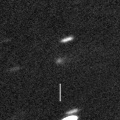
|
Now it is 17.0 mag (Dec. 31, Toshihiko Ikemura, Hirohisa Sato). It stays observable at 17 mag in good condition until February. It locates somewhat low in the Southern Hemisphere.
Date(TT) R.A. (2000) Decl. Delta r Elong. m1 Best Time(A, h)
Feb. 2 8 3.01 22 54.2 1.616 2.582 165 17.0 23:13 ( 0, 78)
Feb. 9 7 58.30 22 34.9 1.664 2.603 157 17.1 22:41 ( 0, 78)
|
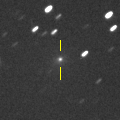
|
Now it is 16.5 mag (Jan. 3, Toshihiko Ikemura, Hirohisa Sato). It will be fading after this, and it will be fainter than 18 mag in March.
Date(TT) R.A. (2000) Decl. Delta r Elong. m1 Best Time(A, h)
Feb. 2 4 31.52 20 3.1 1.106 1.781 116 17.0 19:43 ( 0, 75)
Feb. 9 4 39.01 22 26.2 1.171 1.789 111 17.2 19:23 ( 0, 78)
|
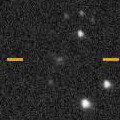
|
Now it is 17.4 mag (Jan. 3, Toshihiko Ikemura, Hirohisa Sato). It stays 16 mag for a long time from 2019 to 2020. It is observable in excellent condition in the Southern Hemisphere. It is hardly observable in the Northern Hemisphere.
Date(TT) R.A. (2000) Decl. Delta r Elong. m1 Best Time(A, h)
Feb. 2 14 18.08 -42 22.3 4.370 4.413 86 17.1 5:32 ( 0, 13)
Feb. 9 14 17.16 -44 5.2 4.230 4.375 91 17.0 5:03 ( 0, 11)
|
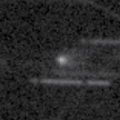
|
Now it is 17.0 mag (Jan. 6, Toshihiko Ikemura, Hirohisa Sato). It will be fading after this, and it will be fainter than 18 mag in March. It locates low in the Southern Hemisphere.
Date(TT) R.A. (2000) Decl. Delta r Elong. m1 Best Time(A, h)
Feb. 2 11 12.88 28 15.0 1.850 2.733 147 17.2 2:27 ( 0, 83)
Feb. 9 11 7.59 29 22.5 1.858 2.774 152 17.2 1:54 ( 0, 84)
|

|
Now it is 17.1 mag (Dec. 31, Toshihiko Ikemura, Hirohisa Sato). Fading slowly. It stays observable at 17 mag in good condition until summer.
Date(TT) R.A. (2000) Decl. Delta r Elong. m1 Best Time(A, h)
Feb. 2 11 42.69 7 2.1 9.200 9.966 139 17.2 2:57 ( 0, 62)
Feb. 9 11 41.82 7 20.2 9.140 9.977 146 17.2 2:28 ( 0, 62)
|

|
Now it is 16.5 mag (Jan. 10, Toshihiko Ikemura, Hirohisa Sato). It is observable at 17 mag in good condition in 2019. It locates somewhat low in the Northern Hemisphere.
Date(TT) R.A. (2000) Decl. Delta r Elong. m1 Best Time(A, h)
Feb. 2 15 37.67 -15 29.3 3.856 3.756 76 17.3 5:32 (336, 36)
Feb. 9 15 42.73 -15 45.7 3.760 3.763 82 17.2 5:27 (341, 37)
|
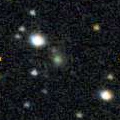
|
Now it is 16.3 mag (Jan. 6, Toshihiko Ikemura, Hirohisa Sato). It is expected to be observable at 5-6 mag for a long time from 2022 to 2023. It will be observable in good condition for a long time in the Southern Hemisphere. In the Northern Hemisphere, it is not observable at the highlight from 2022 summer to 2023 summer.
Date(TT) R.A. (2000) Decl. Delta r Elong. m1 Best Time(A, h)
Feb. 2 18 2.28 52 16.0 12.483 12.338 79 17.4 5:32 (228, 47)
Feb. 9 18 4.95 52 33.3 12.418 12.293 80 17.4 5:27 (228, 50)
|
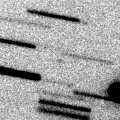
|
Now it is 17.8 mag (Jan. 5, Toshihiko Ikemura, Hirohisa Sato). It will be fading after this, and it will be fainter than 18 mag in late February. It locates very low in the Southern Hemisphere.
Date(TT) R.A. (2000) Decl. Delta r Elong. m1 Best Time(A, h)
Feb. 2 11 24.98 38 8.9 0.744 1.637 141 17.4 2:39 (180, 87)
Feb. 9 11 21.42 38 30.9 0.759 1.670 145 17.6 2:08 (180, 87)
|
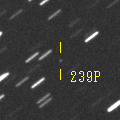
|
Now it is 17.2 mag (Dec. 31, Toshihiko Ikemura, Hirohisa Sato). It will be fading after this, and it will be fainter than 18 mag in March.
Date(TT) R.A. (2000) Decl. Delta r Elong. m1 Best Time(A, h)
Feb. 2 8 6.26 -1 52.9 0.715 1.667 156 17.5 23:17 ( 0, 53)
Feb. 9 8 5.18 -2 21.0 0.739 1.680 153 17.6 22:48 ( 0, 53)
|
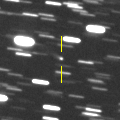
|
Now it is 17.2 mag (Dec. 31, Toshihiko Ikemura, Hirohisa Sato). It will be fading after this, and it will be fainter than 18 mag in April.
Date(TT) R.A. (2000) Decl. Delta r Elong. m1 Best Time(A, h)
Feb. 2 4 26.20 3 57.4 7.692 8.108 111 17.6 19:37 ( 0, 59)
Feb. 9 4 23.44 3 54.8 7.817 8.117 104 17.7 19:07 ( 0, 59)
|

|
Now it is 17.5 mag (Jan. 19, Catalina Sky Survey). In the Northern Hemisphere, it is observable at 17.5 mag in good condition in February. It is not observable in the Southern Hemisphere.
Date(TT) R.A. (2000) Decl. Delta r Elong. m1 Best Time(A, h)
Feb. 2 11 37.50 69 59.7 0.980 1.718 121 17.8 2:56 (180, 55)
Feb. 9 8 52.57 71 47.4 0.934 1.687 122 17.6 23:22 (180, 54)
|
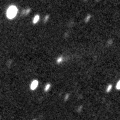
|
Now it is 16.7 mag (Jan. 5, Toshihiko Ikemura, Hirohisa Sato). It will be fading after this, and it will be fainter than 18 mag in late February.
Date(TT) R.A. (2000) Decl. Delta r Elong. m1 Best Time(A, h)
Feb. 2 6 52.72 3 25.7 2.261 3.126 145 17.7 22:03 ( 0, 58)
Feb. 9 6 50.46 3 57.0 2.329 3.146 139 17.8 21:34 ( 0, 59)
|

|
Now it is 17.9 mag (Jan. 3, Toshihiko Ikemura, Hirohisa Sato). It stays 17 mag from spring to summer. But it is hardly observable. In the Northern Hemisphere, it is observable only until May. In the Southern Hemisphere, it stays locating extremely low.
Date(TT) R.A. (2000) Decl. Delta r Elong. m1 Best Time(A, h)
Feb. 2 3 44.31 48 7.2 2.282 2.777 109 17.7 18:56 (180, 77)
Feb. 9 3 49.74 47 12.6 2.309 2.728 104 17.7 19:01 (160, 77)
|
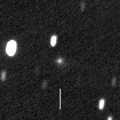
|
Now it is 16.9 mag (Dec. 31, Toshihiko Ikemura, Hirohisa Sato). It will be fading after this, and it will be fainter than 18 mag in March. It locates very low in the Southern Hemisphere.
Date(TT) R.A. (2000) Decl. Delta r Elong. m1 Best Time(A, h)
Feb. 2 5 46.15 43 51.3 3.165 3.887 131 17.7 20:57 (180, 81)
Feb. 9 5 44.73 43 42.1 3.253 3.900 124 17.8 20:28 (180, 81)
|
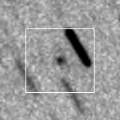
|
Now it is 17.6 mag (Dec. 31, Toshihiko Ikemura, Hirohisa Sato). First return of a new periodic comet which brightened up to 16 mag in 2011. It will be fading after this, and it will be fainter than 18 mag in March.
Date(TT) R.A. (2000) Decl. Delta r Elong. m1 Best Time(A, h)
Feb. 2 3 1.67 11 44.7 2.081 2.360 93 17.8 18:55 ( 25, 65)
Feb. 9 3 9.80 11 57.6 2.157 2.351 88 17.8 19:01 ( 38, 62)
|

|
It was expected to be observable at 17.5 mag in good condition in winter in the Northern Hemisphere. But actually, it is so faint as 19.7 mag (Dec. 29, Kunihiro Shima). It locates low in the Southern Hemisphere.
Date(TT) R.A. (2000) Decl. Delta r Elong. m1 Best Time(A, h)
Feb. 2 5 8.44 34 58.8 2.323 3.007 125 17.8 20:20 (180, 90)
Feb. 9 5 9.12 34 58.3 2.397 3.002 118 17.8 19:53 ( 0, 90)
|

|
Now it is 17.9 mag (Jan. 3, Toshihiko Ikemura, Hirohisa Sato). It is observable at 18 mag in good condition from January to February. It locates low in the Southern Hemisphere.
Date(TT) R.A. (2000) Decl. Delta r Elong. m1 Best Time(A, h)
Feb. 2 10 43.12 31 34.6 1.015 1.943 152 17.9 1:57 ( 0, 87)
Feb. 9 10 36.98 30 45.7 1.011 1.960 157 17.9 1:24 ( 0, 86)
|
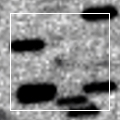
|
Now it is 17.9 mag (Dec. 31, Toshihiko Ikemura, Hirohisa Sato). It is observable at 18 mag in winter.
Date(TT) R.A. (2000) Decl. Delta r Elong. m1 Best Time(A, h)
Feb. 2 6 31.01 22 27.6 2.632 3.482 144 17.9 21:42 ( 0, 77)
Feb. 9 6 28.48 22 37.5 2.691 3.477 136 18.0 21:12 ( 0, 78)
|
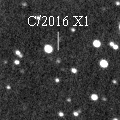
|
Now it is 17.8 mag (Jan. 6, Toshihiko Ikemura, Hirohisa Sato). It is observable at 18 mag in winter.
Date(TT) R.A. (2000) Decl. Delta r Elong. m1 Best Time(A, h)
Feb. 2 7 12.31 3 52.7 6.710 7.583 150 17.9 22:23 ( 0, 59)
Feb. 9 7 10.52 3 53.1 6.757 7.580 144 17.9 21:54 ( 0, 59)
|
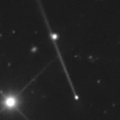
|
Main-belt asteroid. But it shows a straight tail like a comet. Now it is 17.2 mag (Jan. 12, Toshihiko Ikemura, Hirohisa Sato). It stays observable in excellent condition until early summer.
Date(TT) R.A. (2000) Decl. Delta r Elong. m1 Best Time(A, h)
Feb. 2 10 42.77 -11 58.1 1.571 2.421 141 18.1 1:57 ( 0, 43)
Feb. 9 10 38.41 -11 10.6 1.509 2.407 148 17.9 1:25 ( 0, 44)
|
|
![]()
 C/2017 B3 ( LINEAR )
C/2017 B3 ( LINEAR ) C/2018 A3 ( ATLAS )
C/2018 A3 ( ATLAS ) C/2017 T2 ( PanSTARRS )
C/2017 T2 ( PanSTARRS ) 240P/NEAT
240P/NEAT 21P/Giacobini-Zinner
21P/Giacobini-Zinner P/2014 C1 ( TOTAS )
P/2014 C1 ( TOTAS ) C/2018 W2 ( Africano )
C/2018 W2 ( Africano ) C/2017 T3 ( ATLAS )
C/2017 T3 ( ATLAS ) C/2010 U3 ( Boattini )
C/2010 U3 ( Boattini ) C/2016 A1 ( PanSTARRS )
C/2016 A1 ( PanSTARRS ) 59P/Kearns-Kwee
59P/Kearns-Kwee 171P/Spahr
171P/Spahr C/2018 F4 ( PanSTARRS )
C/2018 F4 ( PanSTARRS ) 164P/Christensen
164P/Christensen C/2014 B1 ( Schwartz )
C/2014 B1 ( Schwartz ) 74P/Smirnova-Chernykh
74P/Smirnova-Chernykh C/2017 K2 ( PanSTARRS )
C/2017 K2 ( PanSTARRS ) 247P/LINEAR
247P/LINEAR 239P/LINEAR
239P/LINEAR C/2015 XY1 ( Lemmon )
C/2015 XY1 ( Lemmon ) C/2019 B1 ( Africano )
C/2019 B1 ( Africano ) 361P/2017 S4 ( Spacewatch )
361P/2017 S4 ( Spacewatch ) C/2018 X2 ( Fitzsimmons )
C/2018 X2 ( Fitzsimmons ) 159P/LONEOS
159P/LONEOS 373P/2018 R2 ( Rinner )
373P/2018 R2 ( Rinner ) 232P/Hill
232P/Hill 375P/2018 T1 ( Hill )
375P/2018 T1 ( Hill ) 31P/Schwassmann-Wachmann 2
31P/Schwassmann-Wachmann 2 C/2016 X1 ( Lemmon )
C/2016 X1 ( Lemmon ) (6478) Gault
(6478) Gault![]()







































